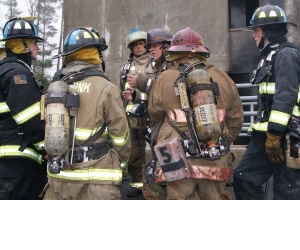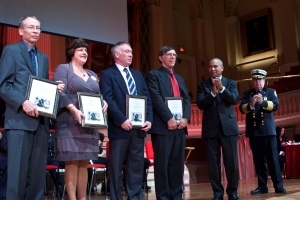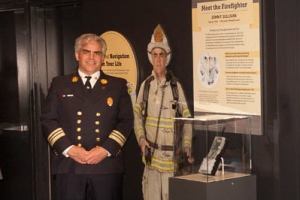
Fifteen years ago, on Dec. 3, 1999, the tragic Worcester Cold Storage warehouse fire devastated this New England city and galvanized the nation. The fire, which took the lives of six local firefighters, became the impetus for a major research program at Worcester Polytechnic Institute (WPI) that has produced a string of innovations designed to make the work of first responders safer and more effective.
That pioneering work has been conducted by WPI's Center for First Responder Technology, which was formed in the immediate aftermath of the fire. In addition to investing 15 years of research into developing better and more affordable technologies for firefighters and other first responders, WPI researchers have also worked relentlessly to raise awareness about the need for new lifesaving technology in the fire service and to promote communication and cooperation among researchers, funders, and advocates in government, academia, industry, and the first responder community. These efforts helped spark a national focus on the need to better equip firefighters for the dangerous work they do.

These dual efforts—to pioneer new technology to safeguard the lives and health of first responders and to help form and spur on a national community focused on this important national need, has won WPI's team a number of accolades, including the Massachusetts State Fire Marshal's Award, presented to professors Orr, Cyganski, Duckworth, and Notarianni by Governor Deval Patrick in 2012 during the 23rd Annual "Firefighter of the Year" award ceremony at Mechanics Hall in Worcester. The honor recognizes significant contributions to the fire service made by those outside of the service.
Getting Started:
The Worcester Cold Storage tragedy began when two firefighters entered the windowless, maze-like building in search of two homeless residents who were believed to be inside. When they became lost, two other firefighters were sent in to look for them. A third team entered the building when the rescuers, themselves, became disoriented in the dense smoke. Ultimately, all six firefighters perished.
As he watched the procession of thousands of firefighters from around the nation who gathered that December to memorialize their fallen comrades, John Orr, professor and former head of the WPI Department of Electrical and Computer Engineering at WPI, wondered if there might be a technological innovation that could help rescue teams quickly locate and rescue lost or trapped firefighters.
He formed a team that included David Cyganski, professor of electrical and computer engineering and currently dean of engineering ad interim, and James Duckworth, associate professor of electrical and computer engineering. They began exploring a three-dimensional location system using radio transmitters worn by firefighters and receivers located outside of a burning building or carried by rescue teams.
Initially, the WPI researchers focused only on the problem of precisely locating firefighters inside buildings. Over time, they began to investigate solutions for many additional risks faced by firefighters and other first responders.
Research and Development:
In 2004, with the aid of Congressman James P. McGovern, the team won a major award from the U.S. Department of Justice, the first of several grants they would receive over the years from such agencies as the Department of Homeland Security (DHS) and the Federal Emergency Management Agency (FEMA). The research has also been supported by a number of technology companies, including Honeywell and Airbus Defence and Space (formerly Astrium). The team discovered early on that precise three-dimensional personnel location inside buildings, where GPS signals do not reach, is a daunting challenge, as radio signals bounce off walls, floors, and other surfaces, making it difficult to tell where they originate (a phenomenon known as multipath).
Over the years, the researchers, working with teams of graduate students, developed and tested multiple variations on their radio frequency technology (including systems that also incorporated inertial navigation units to help compensate for multipath errors), along with increasingly sophisticated computer algorithms that helped tackle the multipath challenge. This work brought them steadily closer to the overall goal of reliably locating firefighters in three dimensions to within inches using technology that is affordable for most fire companies.
This year, after a decade and a half of uninterrupted research, the team has taken major strides toward that target with new approaches that use radio frequency location alone and in concert with inertial navigation and image processing. The team expects to make a major announcement regarding this work in the coming months.
Throughout the development process, the WPI researchers have worked closely with the Worcester Fire Department, the Massachusetts Firefighting Academy, and other first responders to gain a clearer understanding of the nature of a firefighter's job and the realities of the fire service. In the process, they have learned of other challenges and dangers that firefighters face that could also be addressed through technology. They have mounted separate research programs to address them.
- Physiological Monitoring: From interactions with firefighters, the WPI researchers learned that stress-related heart attacks are the leading cause of firefighter fatalities. In response, they added technology to their location system that can monitor a firefighter's vital signs. This work was funded by a major award from FEMA. Among the technology tested is a wireless, wearable pulse oximeter developed by Duckworth and Yitzhak Mendelson, associate professor and interim head of the Department of Biomedical Engineering.
- Flashover Prediction: With an award from FEMA, Cyganski, Duckworth, and a research team from WPI's Department of Fire Protection Engineering, led by Professor Kathy Notarianni, developed a system that can accurately predict the onset of the deadly phenomenon known as flashover—the moment when all combustible materials in a room simultaneously erupt in flames—up to a minute before it occurs. The system is designed to give firefighters adequate time to move away from the danger.
- Toxic Gas Detection: In work also funded by FEMA, Cyganski, Duckworth, and Notarianni have developed a sensor that can warn firefighters of the presence of carbon monoxide in and adjacent to the fire ground. This and other odorless toxic gases generated by combustion pose significant immediate and long-term health threats to members of the fire service. Firefighters typically remove their air masks after leaving a burning building, unaware that toxin levels can still be high in presumably safe areas. Having undergone extensive tests in WPI's Fire Protection Engineering Laboratory and at the Massachusetts Firefighting Academy, the sensor was recently tested in the field by more than 50 firefighters from the Worcester Fire Department during actual incidents.
- Fireproof Attack Hose: With funding from the Last Call Foundation, established by Kathy Crosby-Bell, mother of Boston firefighter Michael Kennedy, Notarianni and Raymond Ranellone, research engineer in fire protection engineering, are working to fix a weak link in the chain of technology used to fight fires by taking the first steps toward the development of a fireproof attack hose. Made from woven cotton and rubber, existing fire hoses can burn through when they are not charged with water. Kennedy and fellow firefighter Edward Walsh Jr. died in a March 2014 blaze, and it appears likely that a damaged hose was a major factor in those deaths.
First Responder Workshops:
Another outcome of WPI's close collaboration with the fire service was a series of annual workshops, hosted by WPI's Center for First Responder Technology, that bring together academic and corporate researchers, government agencies, and first responders to share ideas and new research developments, assess the state of the field, and outline future challenges. The workshops have provided a unique venue where technology developers can learn about the real-world needs of first responders, where first responders can evaluate and critique emerging technology, and where government agencies can develop a clearer picture of how they can spur needed change and technology progress. Funded in recent years by the DHS Science and Technology Directorate, the workshops have played an instrumental role in accelerating the pace of technological development and raising awareness, nationally, of the pressing need to focus resources and energy on finding solutions to the challenges and hazards that first responders face every day.

